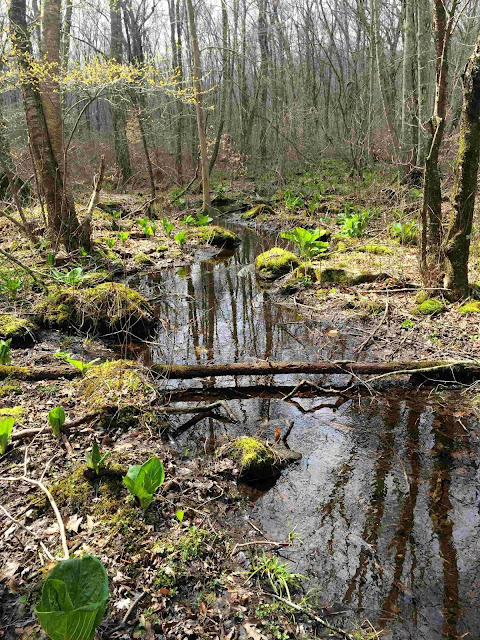By Beth Sullivan
Finally! While the
Connecticut College students were busy doing their projects and
writing the blog for the last several weeks, winter finally
breathed its last and spring jumped in with both feet, making up for
lost time. It is amazing to me, that despite the long extended cold,
things seemed to catch up and happen on time, as they always have.
Spring has arrived
My Quince bushes were a
little delayed in flowering, but my Hummingbird returned to the yard,
looking for the feeder, right on target: April 27. The cold weather
seemed to keep down the insect populations early in the season, and I
truly hoped the insect-eating birds would take their time and maybe
take a bit of an extended rest stop farther south. It seems they
did. At least my Phoebe was a week later than usual in announcing
her presence. But everything is on schedule now. We are beset with
gnats and flies, and the sweet little bird spends hours at the edge
of the woods, making quick upward and outward flights to grab her
meals.
I hope I am not jinxing
anything by reporting that many flowering trees seem to have come
through the winter and early blooming time, without showing the
devastation from the winter moths, as they have in previous years.
Barring a severe freeze, this could be a bumper year for beautiful
blossoms and later abundant fruits. Of course we also have to hope
all the species of native bees have survived the winter to do the
pollinating. We can also hope that last year’s severe die-off of
Gypsy moth caterpillars will result in fewer areas of devastation
this year. There is still time to search out egg masses and scrape
them away. I found a number inside my birdhouses as I cleaned them
for their feathered occupants.
This is just such a
spectacular time of year, creating a welcome sensory overload for
those of us who are truly passionate about watching every little
natural change. Every day brings something new: the arrival of a new
bird, the opening of a favorite woodland wildflower. Sometimes things
happen over hours, like the unfurling of a fern fiddlehead, or the
chorus of spring frogs starting slow then reaching a beautiful peak
at sunset and for a few hours beyond. Every night is different as
voices change over the weeks. The Wood Frogs seem to be finished,
the Spring Peepers continue but less vigorously and have now been
joined by Gray Tree Frogs.
The
wetlands seem to be where spring life really begins, and over the
weeks they have changed from brittle brown to lush green and yellow:
Skunk Cabbage, False Hellebore, Sphagnum Moss and Marsh Marigolds.
Standing pools are alive with water striders, swarms of small flies,
and masses of amphibian eggs are that just days from hatching. The
single heart-shaped leaves of thousands of Canada Mayflowers create
a carpet of green occasionally dotted with the white or lavender-blue
of violets. The very precious Dog tooth Violet makes a brief
appearance in the moist wet woodland soils.
 |
| The Hummingbirds arrived right on time, finding a full feeder. |
 |
A Phoebe relies on warm weather hatches of flying insects to survive. Photograph by Dennis Main. |
 |
| Lush green with yellow and violet create a wetland mosaic. |
 |
Canada Mayflowers will carpet the woodland floor by the thousands. |
So much to see, so much to share
The season is fleeting. The trees and shrubs will leaf
out, closing our views and shading the forest floors. Wetlands will
dry out and the chorus of frogs will change to the more solitary
vocals of the larger species.
Please take some time
for yourself to seek out a new preserve, or an old favorite, and make
note of this wonderful season. We can be so grateful that Avalonia
has, over the years, preserved 4000 acres of springtime beauty, just
for us to enjoy. The website lists all the trails and Hike and Seek
gives you a challenge to open your eyes and look for some very
special features. Enjoy.
 |
| The Trout Lilly or Dog Tooth Violet is a fleeting gem. |
 |
| Brooks and pools in the Woodlot Sanctuary teem with life. |
 |
| You can almost see the fiddlehead ferns uncurling in front of your very eyes. |
Photographs by Beth
Sullivan unless otherwise indicated.

No comments:
Post a Comment